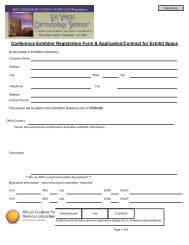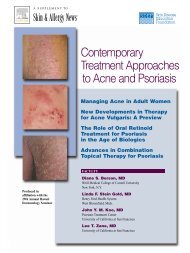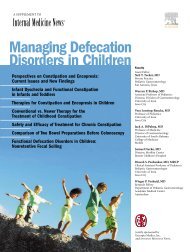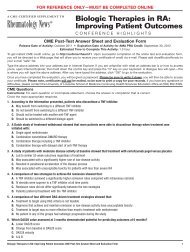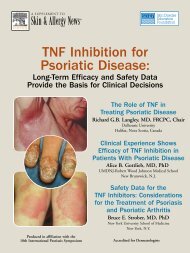Skin & Allergy News® - Global Academy for Medical Education
Skin & Allergy News® - Global Academy for Medical Education
Skin & Allergy News® - Global Academy for Medical Education
You also want an ePaper? Increase the reach of your titles
YUMPU automatically turns print PDFs into web optimized ePapers that Google loves.
at least two ways: (1) by reducing the<br />
proliferation of resistant strains of P.<br />
acnes that were present prior to the start<br />
of therapy and (2) by decreasing the<br />
emergence of antibiotic-resistant strains<br />
during therapy. In the presence of antibiotics,<br />
highly active benzoyl peroxide radicals<br />
<strong>for</strong>m, resulting in damage to the<br />
biofilm, which in turn enhances penetration<br />
of the antibiotic.<br />
Clinicians can take a number of<br />
steps to avoid contributing to the further<br />
emergence and proliferation of antibiotic-resistant<br />
strains of P. acnes. In general,<br />
of course, the use of any antibiotics<br />
should be limited to proven indications.<br />
With regard to acne vulgaris, specifically,<br />
topical retinoids should be tried <strong>for</strong> initial<br />
treatment. Antibiotic monotherapy<br />
<strong>for</strong> acne—either topical or oral—should<br />
be avoided. If antibiotic treatment is indicated,<br />
the duration of the initial course<br />
should be limited to the time it takes to<br />
bring the inflammatory process under<br />
control, most commonly seen within 12<br />
weeks of treatment. Topical therapy<br />
should be initiated at the same time and<br />
continued <strong>for</strong> maintenance beyond the<br />
use of oral antibiotics. Combination<br />
products may facilitate continued longterm<br />
treatment with a retinoid and benzoyl<br />
peroxide or a topical antibiotic and<br />
a benzoyl peroxide.<br />
Acne in <strong>Skin</strong> of Color:<br />
Special Considerations<br />
The ethnic population in the United<br />
States has been increasing <strong>for</strong> several<br />
decades, and further significant increases<br />
are predicted <strong>for</strong> the near future. Thus,<br />
clinicians will be treating larger numbers<br />
of patients of color <strong>for</strong> common skin<br />
conditions such as acne, and it will be<br />
necessary <strong>for</strong> clinicians to refine treatments<br />
to prevent the unique challenge of<br />
postinflammatory hyperpigmentation<br />
seen in these patients.<br />
In darker skin, comedones seem to<br />
have a stronger inflammatory component,<br />
TABLE 2. Pathophysiologic Targets of Acne Medications<br />
and a hyperreactivity of melanocytes also<br />
exists that increases the risk <strong>for</strong> dyschromia.<br />
In fact, postinflammatory hyperpigmentation<br />
often is the primary reason<br />
<strong>for</strong> patients of color to consult a dermatologist.<br />
15,16<br />
The main challenge in successful<br />
therapy <strong>for</strong> acne in this patient population<br />
is to start anti-inflammatory therapy<br />
early and to treat aggressively. However,<br />
it is also extremely important to select<br />
topical agents carefully to prevent excessive<br />
irritation of the skin, which may<br />
itself cause pigment changes. Lower concentrations<br />
of benzoyl peroxide and<br />
retinoids in cream vehicles may be considered.<br />
15.16<br />
Enhancing Compliance:<br />
Practical Tips <strong>for</strong> Clinicians<br />
In addition to educating patients<br />
about the causes of acne and the types of<br />
medications that can be considered in<br />
individual cases, some other specific messages<br />
should be stressed. Some of these<br />
may seem obvious to clinicians, but they<br />
are usually not obvious to patients.<br />
Patients must be realistic about<br />
their expectations about treatment. The<br />
most rational approach to acne therapy is<br />
“slow and steady,” and there are no<br />
quick or easy remedies to solve the problem.<br />
They should understand that there is<br />
no “cure” <strong>for</strong> acne. The goal is effective<br />
symptom control, and to achieve it,<br />
patients must participate in the process<br />
and recognize that it takes work to manage<br />
their condition. Toward that end,<br />
compliance over the long term can be<br />
enhanced if the initial treatment focus is<br />
on prompt and effective anti-inflammatory<br />
control be<strong>for</strong>e introducing other,<br />
more complex treatment goals.<br />
Many patients are aware that some<br />
oral medications are used to treat acne,<br />
and it may seem like an attractive option<br />
compared to complicated topical regimens.<br />
For this reason, the option of oral<br />
medication should be addressed, and an<br />
Propionibacterium<br />
Sebum<br />
Comedones acnes Inflammation Production<br />
Benzoyl peroxide +/++ ++ ++ –<br />
Topical retinoids ++++ – ++ –<br />
Topical antibiotics + ++ ++ –<br />
Benzoyl peroxide/antibiotics +/++ +++ +++ –<br />
Topical antibiotics/ retinoids ++++ +++ ++++ –<br />
Oral antibiotics + ++++ +++ –<br />
Oral contraceptives + + ++ ++<br />
+ = positive effect on the pathophysiologic target; - = no effect on the pathophysiologic target.<br />
Source: Courtesy of Magdalene A. Dohil, MD.<br />
FIGURE. Range of Acne Lesions<br />
Inflammatory lesions (top) should be treated<br />
early and aggressively to prevent hyperpigmentation<br />
and scarring. Patients with noninflammatory,<br />
mild acne (bottom) may be managed with<br />
nonprescription benzoyl peroxide products.<br />
explanation should be offered regarding<br />
the suitability of such medications in an<br />
individual patient’s case. For those cases<br />
in which oral antibiotics are indicated, it<br />
is important <strong>for</strong> the patient to know from<br />
the outset that the course of therapy will<br />
be limited and why. It is not unusual <strong>for</strong><br />
patients who respond well to the antiinflammatory<br />
action of oral antibiotics to<br />
want to continue taking the medication<br />
indefinitely.<br />
Patients should also be advised that<br />
the initial therapeutic response may be<br />
slow but that they must adhere to the<br />
treatment plan over the long term <strong>for</strong><br />
best results. This may be particularly<br />
difficult if an initial flare occurs when<br />
topical retinoid therapy is initiated.<br />
<strong>Education</strong> about gradual retinization and<br />
the reason why a flare may occur is<br />
essential to prevent premature disuse of<br />
the medication because a patient concluded<br />
that the retinoid not only did not<br />
help the condition but made the acne<br />
“worse.” Patients should be told to<br />
anticipate the possibility of this and other<br />
common often-transient side effects associated<br />
with retinoids, benzoyl peroxide,<br />
and other topical medications.<br />
Along with stressing compliance<br />
with a medication and a proper topical<br />
treatment regimen, clinicians must<br />
explain why sun protection and moisturization<br />
are important <strong>for</strong> all patients, but<br />
especially <strong>for</strong> those using a retinoid.<br />
continued on page 11<br />
Therapeutic Challenges and New Approaches to the Patient With Acne 7





